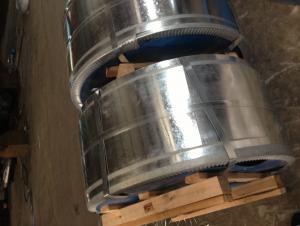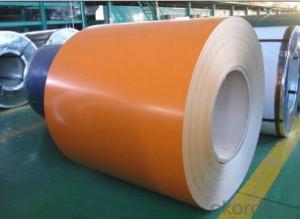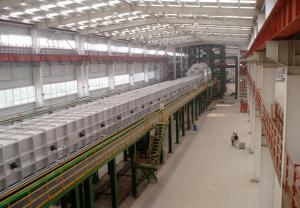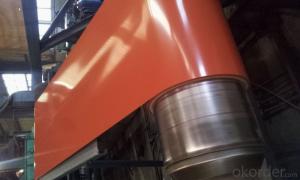Hot Dip Galvanized Steel Strips
- Loading Port:
- China Main Port
- Payment Terms:
- TT OR LC
- Min Order Qty:
- -
- Supply Capability:
- -
OKorder Service Pledge
OKorder Financial Service
You Might Also Like
Product Description:
Hot Dipped Galvanized Steel Strips
Hot-dip galvanized steel strips are available with a pure zinc coating through the hot-dip galvanizing process. It offers the economy, strength and formability of steel combined with the corrosion resistance of zinc. The hot-dip process is the process by which steel gets coated in layers of zinc to protect against rust. It is especially useful for countless outdoor and industrial applications.
Product Description Of Hot Dipped Galvanized Steel Strips
Thickness | 0.18mm-3mm |
Width | less than 600mm |
Zinc Coating | 30-200g/m2 |
Internal Diameter | 508mm/610mm |
Coil Weight | less than 3MT |
Quality | commercial and structural quality |
Surface Treatment | regular & minimum spangle, zero spangle, oiled & dry, chromated , non-skin pass , skin pass |
Standard | JIS G 3302, ASTM A 653M, EN 10327 |
Steel Grade | SGCC, CS, FS, SS, LFQ, DX51D+Z , S280GD |
Technical Data Of Hot Dipped Galvanized Steel Strips
Chemical Composition | C | Si | Mn | P | S |
0.04-0.06% | 0.01-0.03% | 0.18-0.22% | 0.014-0.016% | 0.006%-0.009% |
Yield Strength | (Mpa) 280-320 |
Tensile Strength | (Mpa) 340-390 |
Elongation | 20%-30% |
Out-of-square | not exceed 1% Flatness |
Bow | 15mmmax |
Edge Wave | 9mmmax |
Centre Buckle | 8mmmax |
Bending At 180 Degree | No crack, purling and fraction |
Application Of Hot Dipped Galvanized Steel Strips
It can be widely used in transportation, light industry, civil usage and farming. It is also the perfect building material in construction for making roofing tile, steel profiles for wall partition, T-bar, studs, fireproof door, air conditioning duct and home appliance.
- Q: Can steel strips be used in the manufacturing of industrial equipment?
- Yes, steel strips can be used in the manufacturing of industrial equipment. Steel strips are often used as raw materials for various components and parts in industrial machinery and equipment due to their strength, durability, and versatility. They can be formed, shaped, and welded to meet specific requirements, making them suitable for applications in industries such as automotive, construction, aerospace, and more.
- Q: What are the specifications for steel strips used in the production of razor blades?
- The specifications for steel strips used in the production of razor blades typically vary depending on the specific requirements of the manufacturer. However, there are some general specifications that are commonly followed in the industry. Firstly, the steel used for razor blade production is usually a high carbon stainless steel. This type of steel offers excellent strength and corrosion resistance, which are essential qualities for razor blades. The carbon content is typically around 0.6% to 0.8%, ensuring the necessary hardness for sharpness while still maintaining flexibility. In terms of dimensions, the steel strips are usually very thin, with thicknesses ranging from 0.08mm to 0.2mm. The width of the strips can vary but is typically around 10mm to 30mm. The length of the strips can be customized based on the desired length of the razor blades. Surface finish is another important specification for steel strips used in razor blade production. The surface needs to be smooth and free from any defects or imperfections, as this can affect the performance of the blade and cause irritation to the user's skin. Furthermore, the steel strips should possess good edge retention properties to ensure a longer lifespan for the razor blades. This means that the steel should be able to hold its sharpness even after multiple uses. Lastly, the steel strips should be manufactured with consistent quality and precision to ensure uniformity in the final product. This involves strict control over the composition, heat treatment, and production processes to meet the required specifications. It is important to note that these specifications can vary depending on the specific brand or manufacturer, as they may have their own unique requirements or proprietary materials. Therefore, it is always recommended to consult the manufacturer's guidelines or specifications for the exact requirements of steel strips used in the production of razor blades.
- Q: Can steel strips be used for making conveyor belts?
- Yes, steel strips can be used for making conveyor belts. Steel strips offer several advantages for conveyor belt applications. Firstly, steel strips are durable and have high tensile strength, making them suitable for handling heavy loads and withstanding harsh operating conditions. They can resist impact, abrasion, and wear, ensuring a longer lifespan for the conveyor belt. Moreover, steel strips provide excellent stability and dimensional accuracy, which is crucial for maintaining proper tracking and alignment of the conveyor belt. Additionally, steel strips can be easily joined together to create a continuous belt, allowing for seamless material transportation. Overall, steel strips are a popular choice for conveyor belt manufacturing due to their strength, durability, and versatility.
- Q: How are steel strips tested for internal defects?
- Steel strips are typically tested for internal defects using non-destructive testing methods such as ultrasonic testing or magnetic particle inspection. These techniques involve the use of specialized equipment to detect and analyze any internal flaws or irregularities in the steel strips without causing any damage to the material.
- Q: How are steel strips coated for protection?
- Steel strips are coated for protection through a process called galvanization. Galvanization involves applying a layer of zinc to the surface of the steel strips. This is done by either hot-dip galvanizing or electroplating. In hot-dip galvanizing, the steel strips are immersed in a bath of molten zinc at a temperature of around 450°C (842°F). The zinc reacts with the steel, forming a protective layer of zinc-iron alloy on the surface. This layer provides excellent corrosion resistance and protects the steel from rusting. Electroplating, on the other hand, involves immersing the steel strips in an electrolyte solution containing zinc ions. A direct electric current is then passed through the solution, causing the zinc ions to bond with the steel surface. This creates a thin but durable layer of zinc coating that safeguards the steel from corrosion. Both hot-dip galvanizing and electroplating provide effective protection for steel strips. The zinc coating acts as a barrier, preventing moisture and corrosive elements from reaching the steel surface. Additionally, even if the coating gets scratched or damaged, the sacrificial properties of zinc ensure that it corrodes first, protecting the underlying steel. Overall, steel strips are coated for protection using galvanization techniques, which involve the application of a zinc layer. This process significantly enhances the durability and longevity of the steel, making it more resistant to corrosion and extending its lifespan.
- Q: What is the typical size range of steel strips?
- The typical size range of steel strips can vary depending on the application, but they are generally available in widths ranging from a few millimeters to several hundred millimeters, and thicknesses ranging from a fraction of a millimeter to a few millimeters.
- Q: Are steel strips suitable for making household appliances?
- Yes, steel strips are suitable for making household appliances. Steel is a strong and durable material that can withstand the rigors of daily use. It provides stability, resistance to corrosion, and can be easily molded into various shapes and sizes required for household appliances. Additionally, steel strips offer a sleek and modern aesthetic, making them a popular choice for appliance manufacturers.
- Q: What are the different types of steel strips?
- There are several different types of steel strips, including cold-rolled steel strips, hot-rolled steel strips, galvanized steel strips, stainless steel strips, and alloy steel strips. These types vary in their composition, production method, and properties, making them suitable for different applications and industries.
- Q: How do steel strips respond to different corrosion environments?
- Steel strips can respond differently to various corrosion environments depending on factors such as the type of corrosion, the composition of the steel, and the surrounding conditions. In general, steel strips are susceptible to corrosion, especially when exposed to moisture, oxygen, and aggressive chemicals. However, the response of steel strips to different corrosion environments can vary. In a dry environment with low humidity, steel strips are less likely to corrode significantly. They may develop a thin layer of surface rust, known as cosmetic or superficial corrosion, which does not affect the structural integrity of the steel. This can be easily removed through cleaning or light abrasive methods. In a humid environment, steel strips are more prone to corrosion. The presence of moisture in the air can lead to the formation of rust on the surface of the steel. This type of corrosion can progress over time, causing the steel strips to deteriorate, weaken, and eventually fail if not properly addressed. In marine or saltwater environments, steel strips are highly susceptible to corrosion due to the presence of chloride ions. Chloride ions can penetrate the protective oxide layer on the steel's surface and accelerate the corrosion process. This can lead to the formation of pitting corrosion, which can cause localized damage and weaken the steel strips. Certain chemicals and industrial atmospheres can also contribute to the corrosion of steel strips. Exposure to acids, alkaline substances, or corrosive gases can cause chemical corrosion, which can be highly destructive. The severity of the corrosion depends on factors such as concentration, temperature, and duration of exposure. To mitigate the effects of corrosion, various preventive measures can be taken. Coating the steel strips with protective layers, such as paint or galvanization, can provide a barrier against moisture and corrosive elements. Regular maintenance, including cleaning, inspection, and applying anti-corrosion treatments, can help prolong the lifespan of steel strips in different corrosion environments. Overall, the response of steel strips to different corrosion environments is influenced by multiple factors, and proper prevention and maintenance practices are essential to minimize the impact of corrosion and ensure the longevity of the steel strips.
- Q: How are steel strips used in the production of stampings?
- Steel strips are commonly used in the production of stampings due to their strength, durability, and flexibility. These strips are typically made from various types of steel, such as carbon steel or stainless steel, and come in different thicknesses. In the production process, steel strips are fed into stamping machines, which are equipped with dies or molds. The strips are then shaped or formed into the desired shape or design by the stamping machine. This process can include bending, cutting, punching, or deep drawing, depending on the specific requirements of the stamping. The use of steel strips in stamping offers numerous advantages. Firstly, steel is a strong material, allowing for the production of robust and sturdy stampings that can withstand various forces or pressures. Additionally, steel strips can be easily manipulated and shaped to create intricate and precise stampings, making them suitable for a wide range of applications. Moreover, steel strips provide excellent resistance to corrosion, rust, and wear, making the resulting stampings highly durable and long-lasting. This is particularly important in industries such as automotive, aerospace, or construction, where stampings are subjected to harsh environmental conditions or heavy use. Lastly, steel strips are readily available and cost-effective compared to other materials, making them a popular choice for mass production of stampings. Manufacturers can efficiently produce large quantities of stampings using steel strips, contributing to cost savings and increased productivity. In conclusion, steel strips play a crucial role in the production of stampings. Their strength, durability, flexibility, and cost-effectiveness make them an ideal material for creating high-quality stampings used in various industries.
Send your message to us
Hot Dip Galvanized Steel Strips
- Loading Port:
- China Main Port
- Payment Terms:
- TT OR LC
- Min Order Qty:
- -
- Supply Capability:
- -
OKorder Service Pledge
OKorder Financial Service
Similar products
Hot products
Hot Searches
Related keywords






























